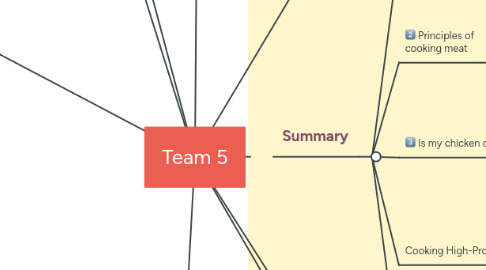
1. Giovana Trevino, Jocelyn Arias, Chris rodriguez, Jose Martinez
2. Key Visuals
2.1. 1- the picture of 319 shows the preparation tips for cakes and high protein flours for bread.
2.2. the equipment on page 321 is used to dry and boil eggs
2.3. on page 322, it shows a paragraph where it is asking if the chicken is done and how it should be cooked.
3. Project Team
4. Key Vocabulary
4.1. Collagen- a protein in connective
4.2. aldehyde-alcohol that has been dehydrogenated.
4.3. ...
4.4. ...
5. https://youtu.be/c7WI41huAok
5.1. The Millard Reaction
6. General Info
7. 2 Assessment Question
7.1. How does the Millard reaction work?
7.2. What are examples of high protein foods?
8. Page numbers
8.1. 319-322
9. Summary
9.1. Develop Gluten
9.1.1. Gluten is a strong cohesive and elastic protein. It is formed when flour is mixed with moisture and stirred/kneaded. Disulfide cross-links are what make gluten so strong. Tiny air bubbles are created as carbon dioxide is released in the dough and causes it to stretch.
9.2. Principles of cooking meat
9.2.1. Most of meats contain 3 categories of meat, which are muscle fibers, connective tissue, and myoglobin. Collagen is a connective tissue of young animals. for example veal, lamb and pork. Meat with little heat can be prepared with dry heat.
9.3. Is my chicken done?
9.3.1. To Check if your chicken is well cooked, you can use a meat thermometer, this one has to reach an internal temperature of 74C
9.3.2. The Millard Reaction
9.3.2.1. When amino acids in grains and meats are heated at high temperature, this creates a chemical reaction that changes the color and flavor of the food
9.4. Cooking High-Protein Foods
9.4.1. High-Protein foods include eggs, milk products, meat, poultry and fish. These foods can be damaged by high cooking temperatures or long cooking periods. This is caused by rapid denaturation. Too much heat will create a dry, rubbery, tough product.
9.5. Principles of Storing and Cooking Eggs
9.5.1. Loss of carbon dioxide through the eggshell causes the deterioration of eggs in storage. As the carbon dioxide moves through the shell, the pH of the egg changes from neutral to basic.

